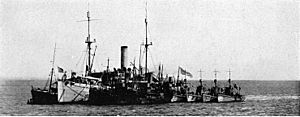USS Panther (1889) facts for kids
 |
|
Quick facts for kids History |
|
|---|---|
| Name | USS Panther |
| Builder | William Cramp & Sons, Philadelphia |
| Laid down | 1889 as SS Venezuela |
| Acquired | by purchase, 12 April 1898 |
| Commissioned | 22 April 1898, as USS Panther |
| Decommissioned | 20 October 1899 |
| Recommissioned | 19 June 1902 |
| Decommissioned | 21 October 1903 |
| Recommissioned | 8 November 1907 |
| Decommissioned | May 1922 |
| Reclassified | AD-6, 1920 |
| Fate | Sold, 24 March 1923 |
| General characteristics | |
| Type | Auxiliary cruiser |
| Displacement | 4,260 long tons (4,328 t) |
| Length | 324 ft 4 in (98.86 m) |
| Beam | 40 ft 6 in (12.34 m) |
| Draft | 18 ft 2.5 in (5.550 m) |
| Propulsion | Steam engine |
| Speed | 13.5 knots (25.0 km/h; 15.5 mph) |
| Armament |
|
The first USS Panther (AD-6) was a special kind of ship for the United States Navy. It started as a merchant ship called SS Venezuela. Later, it became an auxiliary cruiser, which means it helped other warships. It also worked as a troop transport, carrying soldiers from one place to another.
The Panther was built in 1889 by William Cramp & Sons in Philadelphia. As the SS Venezuela, it spent several years as a cargo ship. It even transported bananas from Central and South America! The Navy bought the Panther on April 12, 1898. It was officially put into service, or commissioned, on April 22, 1898. Commander George Cook Reiter was its first captain. In 1920, the Panther was given the new designation AD-6.
Contents
Panther in Action
Spanish–American War: 1898–1899
The Panther was quickly put to work when the Spanish–American War began. It was changed into a troop transport very fast. On April 27, 1898, the ship took on the First Marine Battalion. These Marines were led by Lieutenant Colonel Robert W. Huntington. Just five days later, they sailed from Brooklyn, New York.
The Panther was not really built to carry troops. It was a "banana boat" before! The Marines found it very cramped and hot. This made their spirits low as the ship sailed south. The Panther had no weapons, so it had to stop at Hampton Roads, Virginia. There, it got an armed ship to protect it. Then, it went to Key West, Florida, to wait for orders. The Marines got off the ship there to practice drills and shooting.
The ship then joined the North Atlantic Fleet. Parts of this fleet surrounded Cuba to stop ships from entering or leaving. This is called a blockade. In May, Admiral William T. Sampson heard that Spanish ships might attack near Santiago de Cuba. The Panther and other American ships patrolled there. Later, the Panther sailed to Guantánamo with 633 Marines and 24 officers.
On June 9–10, 1898, the Panther helped the First Marine Battalion land at Caimanera, Cuba, in Guantánamo Bay. They were preparing to take control of the harbor. While landing, Commander Reiter, the Panther's captain, argued with the Marines. He did not want them to unload their ammunition. He said he needed it to balance the ship. But another Navy Commander, Bowman H. McCalla, stepped in. He told Reiter to give the Marines whatever they needed.
From June 11 to 14, 1898, the Marines fought Spanish forces in the Guantánamo Bay area. After some tough fights, the Marines defeated about 500 Spanish soldiers. Six Marines were killed and 16 were wounded. The Panther then went back to join the fleet. It took part in the successful Battle of Santiago de Cuba. After the Spanish fleet was destroyed, the Panther sailed to New York. It then traveled between New York, Boston, Norfolk, and Portsmouth. On October 20, 1899, it was put into storage in Philadelphia.
Caribbean Squadron: 1902–1903
The Panther stayed in storage until June 19, 1902. Then, it was put back into service and set up as a training ship. In July, it went to New York to work with different state militias. It carried crews from New Jersey, Pennsylvania, and Connecticut. In 1902, there were problems in the West Indies. U.S. ships were needed to keep order and protect American rights.
In September 1902, the Panther took on a Marine battalion. It sailed to the Caribbean to act as a station ship. Its job was to protect American interests during unrest in Honduras. It stayed with the Caribbean Squadron until October 21, 1903. Then, it was taken out of service in Philadelphia.
North Atlantic & Asiatic Station: 1907–1923
The Panther was put back into service again on November 18, 1907. It became a support ship for the North Atlantic Fleet until April 1917. It was one of the ships that helped the Great White Fleet on its trip around the world. This famous journey lasted from December 16, 1907, to February 22, 1909. The Panther then sailed to Brest on July 1, 1917. It served as a support ship for U.S. destroyers throughout World War I.
After the war, the Panther visited many ports. These included Kirkwall, Scotland; Devonport, England; Lisbon; and Ponta Delgada. In 1921, America became more interested in China. The Navy had a group of ships called the Yangtze Patrol there. They worked to prevent trouble and protect American people and businesses.
The Panther joined the Asiatic Station's Yangtze River Patrol. It patrolled the river until May 1922. Then, it returned to the United States to be taken out of service. The ship was later sold to Tioga Steel Co. in Philadelphia on March 24, 1923. It was taken apart for its metal in April 1923.


